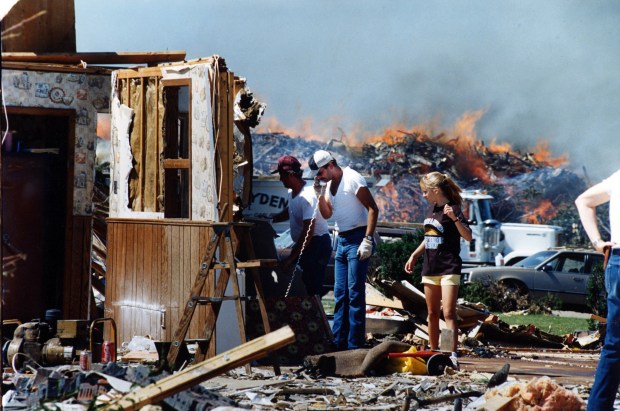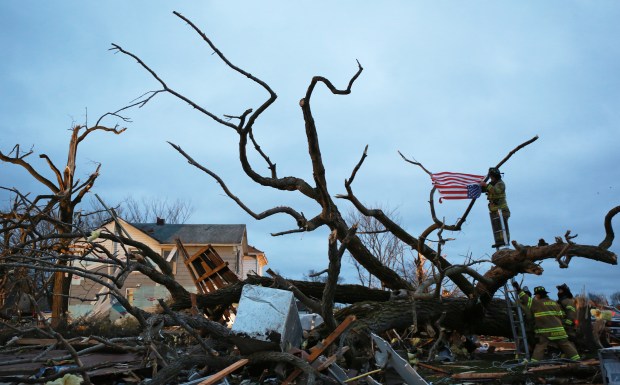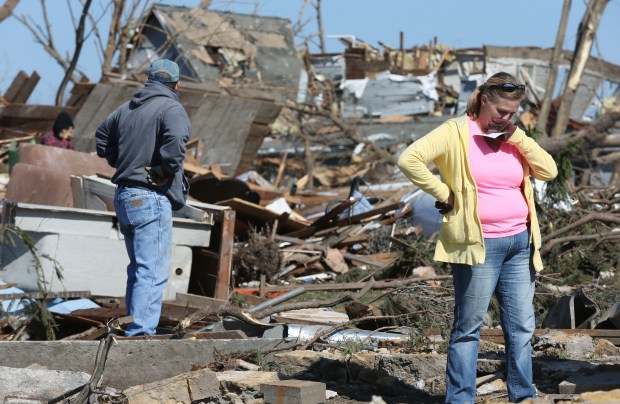Melanie Snow and her husband talk about the weather like it’s gossip.
Every day, they read National Weather Service discussions — technical documents from the agency where meteorologists explain the reasoning and rationale behind forecasts — from weather events in Chicago and across the country.
“We avidly consume those,” Snow said. “And we’re definitely the people in our circle of friends who, if they really want to know the weather for their vacation, wedding, birthday party outside, etcetera, they call us and say: ‘Give me the lowdown.’”
The couple met in college at Georgia Tech, where they both studied to become meteorologists. Then they didn’t. She became a science educator and he became an actuary, but the weather bug stuck with them.
Now, weather hobbyists and enthusiasts — some like Snow and her husband, who might prefer to watch storm clouds from the safety of their porch and others who’d rather chase severe weather for the thrill — are feeling anxious about what federal funding and staffing cuts under the Trump administration could mean for the data they rely on daily from the National Oceanic and Atmospheric Administration and its National Weather Service.
A back-and-forth on staffing has put the agency, like many others, in a state of limbo. Thousands of probationary employees were fired in mid-February, ordered by a federal judge to be rehired a month later and then put on administrative leave, only to see the U.S. Supreme Court block that rehire order last month. Staff shortages have also temporarily suspended and reduced weather balloon releases that track temperature, pressure and wind speed in the Great Plains and Midwest.
Between recent buyouts and mass firings, nearly half of National Weather Service forecast offices had 20% vacancy rates as of April — and eight of 122 offices are missing more than 35% of their staff.
“A lot of people don’t know what goes into making a daily weather report that they access on their app. There are … thousands of NOAA and National Weather Service people (who) are launching weather balloons every day and analyzing that data,” Snow said. “Weather forecasting has come so far, especially in the last 20 years. And to see that decline because of underfunding and firing the people at these organizations is really only harmful (to) everyone — not just enthusiasts.”
While Snow and her husband avidly follow the weather forecasts, a hardy contingent of Illinois storm chasers endeavor to get up close and personal. They are concerned not only about a loss of information but also safety — theirs and those in the path of destructive storms.
“There’s a lot of chatter about what could happen. A lot of worry. We rely on an enormous amount of data that’s put out by the federal government in order to do what we do,” said Skip Talbot, a storm chaser from Springfield. “And vice versa.”
Endangering lives
Most storm chasers have a regular, full-time job, said Talbot, who is a software developer but has traveled a quarter million miles to document 150 tornadoes over the past 20 years.
“We actually do try to make contributions to scientific research as much as we can, and it’s really nice to be helpful out there, make your passion useful,” he said.
Growing up in Oak Brook, Talbot’s fascination was sparked by the strongest August tornado on record in the United States, which occurred in nearby Plainfield in 1990. The tornado, unusual and violent, took the lives of 29 people, injured 350 and caused an estimated $160 million in damages. In college, Talbot took some meteorology courses and received training in spotting and reporting hazards. The weather service relies on storm chasers to be “their eyes out on the field,” he said, as they can’t see everything with radar.
On the ground, chasers also use information from the agency.
“They have a lot of tools that we don’t have around the road,” Talbot said.

For instance, official tornado warnings can help chasers decide where to go when they’re already out. “If there aren’t enough (meteorologists) to work every storm, then we’re not going to get that kind of heads up. … Likewise, we see a lot of stuff when we’re chasing that the weather service just doesn’t know about,” he said.
Weather service offices don’t often have the bandwidth to track down every weather hazard, Talbot said. He has experienced this firsthand when he reports a tornado, and the local office is too busy or understaffed to investigate.
“If there’s less staff,” he said, “nothing will happen with that. So the log will be incorrect; there’ll be errors in the storm data. We’re already seeing some of that. Sometimes the weather service — and I don’t blame them — don’t have the time to put all of these minute details about what happened in these storms. They have to issue the day’s forecast and move on.”
Storm chasers and the public could be at risk if the weather service offers fewer frequent updates and safety warnings. The same could happen if there are limits on public access to NOAA’s high-resolution radar system that detects and analyzes weather as well as its satellite data on temperature, moisture, cloud cover and more.
Some worry about more than limited accessibility to real-time data; many storm chasers are frantically trying to download and compile archive radar data from past events that they rely on for their own research projects.
As extreme weather events intensify because of climate change from human greenhouse gas emissions, past and current data will only become more critical. In the Midwest, as the climate gets warmer and the atmosphere holds more humidity, severe storms are expected to become more frequent.
“I can’t tell you it’s going to cause such and such number of deaths. But I can tell you: You start removing people from these posts and start taking data away — yes, inevitably, somebody is going to die because of that,” Talbot said.
According to a New York Times report, five former weather service directors signed an open letter May 2 warning that cuts to the organization by the Trump administration may endanger lives.
The letter notes that the coming weeks are expected to be especially busy for severe weather: “Airplanes can’t fly without weather observations and forecasts; ships crossing the oceans rely on storm forecasts to avoid the high seas; farmers rely on seasonal forecasts to plant and harvest their crops which feed us. Perhaps most importantly, N.W.S. issues all of the tornado warnings, hurricane warnings, flood warnings, extreme wildfire conditions and other information during extreme weather events.”
Mutually beneficial relationship
Carrie Svihlik’s father was a meteorologist and oceanographer with the U.S. Navy, and she loved watching storm-chasing shows in the early 2010s. But the Kane County elementary school technology teacher never really thought of it as a career to pursue — until she realized modern-day technology and accessible government weather data meant amateur enthusiasts like her could take it up on the side.
“There are things that are taken for granted because they just work. They happen in the background,” Svihlik said. “And you don’t know these things are happening to make things run smoothly. NWS and NOAA are very efficient with what they do.”
Like Snow, Svihlik also shares her passion with her husband Chuck. When they started dating, it became a connection. The couple went on their first local chase a year after getting married, during the Rochelle-Fairdale tornado of 2015. It was one of 11 tornadoes to hit the state that day, and the strongest tornado to occur in northern Illinois in 25 years, killing two and injuring 22 people.


They’ve been chasing ever since, between three to six storms out of state every year, as time allows with their work schedules.
Enthusiasts say the relationship between storm chasers and the weather service is mutually beneficial and strengthens forecasting and warning services that the NWS estimates cost each American about $4 a year. A recent study found that, with a budget of nearly $1.4 billion, the weather service returns more than $102 billion in estimated public value.
“We are all feeling the same things: stress, distress, panic, concern, anger, frustration and sadness, because this is something we’re all passionate and we care about,” Svihlik said. “That’s why (federal workers) got into those fields, and that’s why we do this hobby — we drive millions of miles to look at clouds. And sometimes the clouds don’t do the things that you drove a million miles (to see).”
Besides a regular flurry of hurricanes year in and year out, seeing snowflakes falling on her Florida hometown in January 1977 made a young Snow begin to ask questions about the weather.
“That’s one of the first things that got me hooked,” she said. “It doesn’t snow in Tampa.”
Nowadays, her day job consists of writing high school curricula for an education technology company. She also recently joined the American Meteorological Society’s Weather Band committee board, which does outreach on all things weather.
Practically, she uses publicly accessible government data for everyday decisions. While visiting family in Florida recently and following weather discussions, Snow booked a later return flight once she realized hers would probably get canceled because of tornado activity in the Midwest. She was right.
For now, Snow said she has not noticed any scaling back in the weather service’s daily discussions that she and her husband read. But she worries as tornado season ramps up.
“It’ll be interesting to see how that changes,” she said. “I imagine, long term, that maybe some weather discussions are prioritized over others, (they) can’t do a discussion for every city or every event. Maybe we prioritize any tornado activity because it’s tornado season, or hurricane activity because it’s hurricane season, and other discussions fall to the wayside.”
Climate change will make this trade-off all the more challenging — and consequential, Snow said.
“To deny people access to that information is, really, denying them access to a quality of life,” she added.
Chicago Tribune’s Nara Schoenberg contributed.





